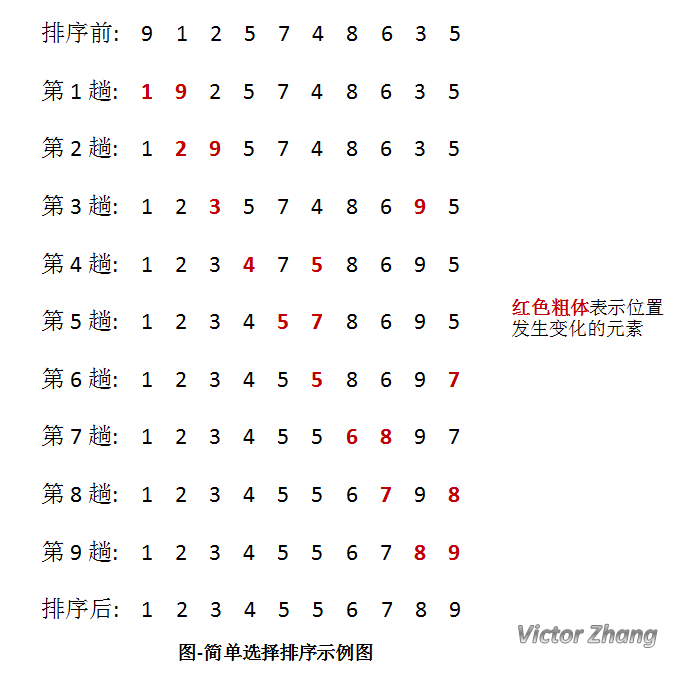排序五 简单选择排序
要点
简单选择排序是一种选择排序。
选择排序:每趟从待排序的记录中选出关键字最小的记录,顺序放在已排序的记录序列末尾,直到全部排序结束为止。
简单排序处理流程
(1)从待排序序列中,找到关键字最小的元素;
(2)如果最小元素不是待排序序列的第一个元素,将其和第一个元素互换;
(3)从余下的 N - 1 个元素中,找出关键字最小的元素,重复(1)、(2)步,直到排序结束。
如图所示,每趟排序中,将当前第 i 小的元素放在位置 i 上。
核心代码
public void selectionSort(int[] list) {
// 需要遍历获得最小值的次数
// 要注意一点,当要排序 N 个数,已经经过 N-1 次遍历后,已经是有序数列
for (int i = 0; i < list.length - 1; i++) {
int temp = 0;
int index = i; // 用来保存最小值得索引
// 寻找第i个小的数值
for (int j = i + 1; j < list.length; j++) {
if (list[index] > list[j]) {
index = j;
}
}
// 将找到的第i个小的数值放在第i个位置上
temp = list[index];
list[index] = list[i];
list[i] = temp;
System.out.format("第 %d 趟:\t", i + 1);
printAll(list);
}
}
// 需要遍历获得最小值的次数
// 要注意一点,当要排序 N 个数,已经经过 N-1 次遍历后,已经是有序数列
for (int i = 0; i < list.length - 1; i++) {
int temp = 0;
int index = i; // 用来保存最小值得索引
// 寻找第i个小的数值
for (int j = i + 1; j < list.length; j++) {
if (list[index] > list[j]) {
index = j;
}
}
// 将找到的第i个小的数值放在第i个位置上
temp = list[index];
list[index] = list[i];
list[i] = temp;
System.out.format("第 %d 趟:\t", i + 1);
printAll(list);
}
}
算法分析
简单选择排序算法的性能
|
排序类别 |
排序方法 |
时间复杂度 |
空间复杂度 |
稳定性 |
复杂性 |
||
|
平均情况 |
最坏情况 |
最好情况 |
|||||
|
选择排序 |
简单选择排序 |
O(N2) |
O(N2) |
O(N2) |
O(1) |
不稳定 |
简单 |
时间复杂度
简单选择排序的比较次数与序列的初始排序无关。 假设待排序的序列有 N 个元素,则比较次数总是N (N - 1) / 2。
而移动次数与序列的初始排序有关。当序列正序时,移动次数最少,为 0.
当序列反序时,移动次数最多,为3N (N - 1) / 2。
所以,综合以上,简单排序的时间复杂度为 O(N2)。
空间复杂度
简单选择排序需要占用 1 个临时空间,在交换数值时使用。
完整参考代码
JAVA版本
代码实现

1 package notes.javase.algorithm.sort;
2
3 import java.util.Random;
4
5 public class SelectionSort {
6
7 public void selectionSort(int[] list) {
8 // 需要遍历获得最小值的次数
9 // 要注意一点,当要排序 N 个数,已经经过 N-1 次遍历后,已经是有序数列
10 for (int i = 0; i < list.length - 1; i++) {
11 int temp = 0;
12 int index = i; // 用来保存最小值得索引
13
14 // 寻找第i个小的数值
15 for (int j = i + 1; j < list.length; j++) {
16 if (list[index] > list[j]) {
17 index = j;
18 }
19 }
20
21 // 将找到的第i个小的数值放在第i个位置上
22 temp = list[index];
23 list[index] = list[i];
24 list[i] = temp;
25
26 System.out.format("第 %d 趟:\t", i + 1);
27 printAll(list);
28 }
29 }
30
31 // 打印完整序列
32 public void printAll(int[] list) {
33 for (int value : list) {
34 System.out.print(value + "\t");
35 }
36 System.out.println();
37 }
38
39 public static void main(String[] args) {
40 // 初始化一个随机序列
41 final int MAX_SIZE = 10;
42 int[] array = new int[MAX_SIZE];
43 Random random = new Random();
44 for (int i = 0; i < MAX_SIZE; i++) {
45 array[i] = random.nextInt(MAX_SIZE);
46 }
47
48 // 调用冒泡排序方法
49 SelectionSort selection = new SelectionSort();
50 System.out.print("排序前:\t");
51 selection.printAll(array);
52 selection.selectionSort(array);
53 System.out.print("排序后:\t");
54 selection.printAll(array);
55 }
56
57 }
2
3 import java.util.Random;
4
5 public class SelectionSort {
6
7 public void selectionSort(int[] list) {
8 // 需要遍历获得最小值的次数
9 // 要注意一点,当要排序 N 个数,已经经过 N-1 次遍历后,已经是有序数列
10 for (int i = 0; i < list.length - 1; i++) {
11 int temp = 0;
12 int index = i; // 用来保存最小值得索引
13
14 // 寻找第i个小的数值
15 for (int j = i + 1; j < list.length; j++) {
16 if (list[index] > list[j]) {
17 index = j;
18 }
19 }
20
21 // 将找到的第i个小的数值放在第i个位置上
22 temp = list[index];
23 list[index] = list[i];
24 list[i] = temp;
25
26 System.out.format("第 %d 趟:\t", i + 1);
27 printAll(list);
28 }
29 }
30
31 // 打印完整序列
32 public void printAll(int[] list) {
33 for (int value : list) {
34 System.out.print(value + "\t");
35 }
36 System.out.println();
37 }
38
39 public static void main(String[] args) {
40 // 初始化一个随机序列
41 final int MAX_SIZE = 10;
42 int[] array = new int[MAX_SIZE];
43 Random random = new Random();
44 for (int i = 0; i < MAX_SIZE; i++) {
45 array[i] = random.nextInt(MAX_SIZE);
46 }
47
48 // 调用冒泡排序方法
49 SelectionSort selection = new SelectionSort();
50 System.out.print("排序前:\t");
51 selection.printAll(array);
52 selection.selectionSort(array);
53 System.out.print("排序后:\t");
54 selection.printAll(array);
55 }
56
57 }
运行结果
排序前: 3 5 2 8 1 2 0 8 4 1
第 1 趟: 0 5 2 8 1 2 3 8 4 1
第 2 趟: 0 1 2 8 5 2 3 8 4 1
第 3 趟: 0 1 1 8 5 2 3 8 4 2
第 4 趟: 0 1 1 2 5 8 3 8 4 2
第 5 趟: 0 1 1 2 2 8 3 8 4 5
第 6 趟: 0 1 1 2 2 3 8 8 4 5
第 7 趟: 0 1 1 2 2 3 4 8 8 5
第 8 趟: 0 1 1 2 2 3 4 5 8 8
第 9 趟: 0 1 1 2 2 3 4 5 8 8
排序后: 0 1 1 2 2 3 4 5 8 8
第 1 趟: 0 5 2 8 1 2 3 8 4 1
第 2 趟: 0 1 2 8 5 2 3 8 4 1
第 3 趟: 0 1 1 8 5 2 3 8 4 2
第 4 趟: 0 1 1 2 5 8 3 8 4 2
第 5 趟: 0 1 1 2 2 8 3 8 4 5
第 6 趟: 0 1 1 2 2 3 8 8 4 5
第 7 趟: 0 1 1 2 2 3 4 8 8 5
第 8 趟: 0 1 1 2 2 3 4 5 8 8
第 9 趟: 0 1 1 2 2 3 4 5 8 8
排序后: 0 1 1 2 2 3 4 5 8 8
参考资料
《数据结构习题与解析》(B级第3版)
相关阅读
欢迎阅读 程序员的内功——算法 系列
示例源码:https://github.com/dunwu/algorithm-notes




